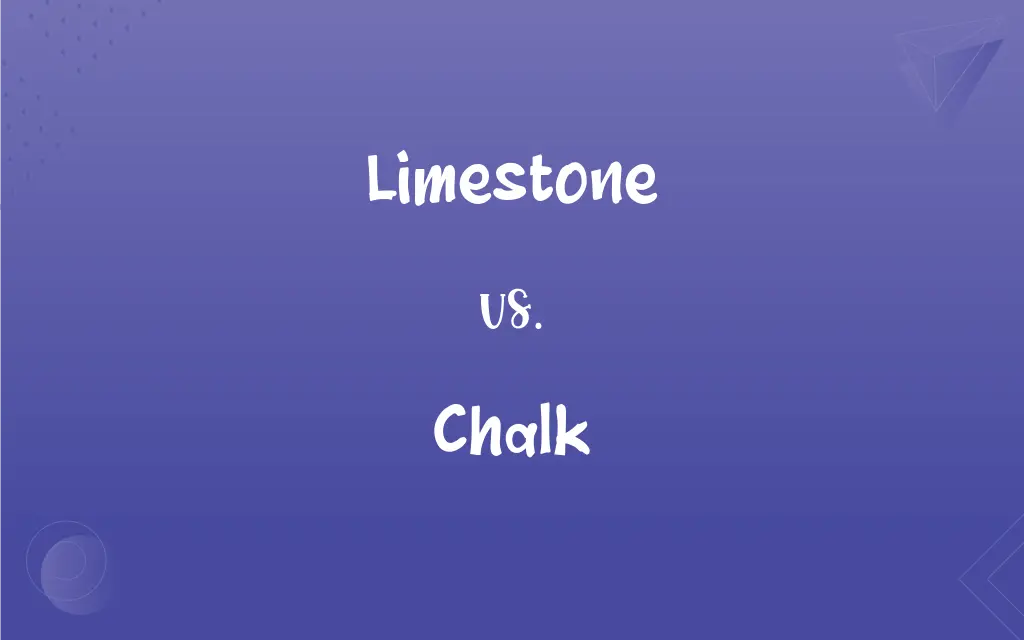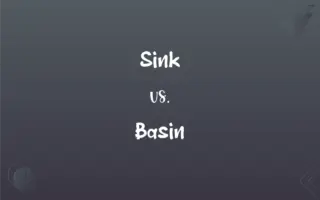Limestone vs. Chalk: What's the Difference?
Edited by Aimie Carlson || By Janet White || Published on December 10, 2023
Limestone is a hard sedimentary rock, mainly composed of calcium carbonate, used in construction and industry, while chalk is a soft, white form of limestone, often used in writing and drawing.

Key Differences
Limestone is a durable sedimentary rock used extensively in construction and for making cement, whereas chalk is a softer, fine-grained form of limestone, known for its use in classroom chalk and art.
The composition of limestone includes various minerals, giving it a range of colors and hardness, while chalk is generally white or light-colored due to its purity and fine texture.
In geology, limestone forms in a variety of environments, including deep-sea beds and caves, whereas chalk typically forms in shallow marine environments, accumulating from the skeletal remains of microorganisms.
Limestone is often used in architectural applications, like in the construction of buildings and monuments, contrasting with chalk, which is commonly used in classrooms and for sidewalk art.
The texture of limestone can vary from smooth to rough, and it's often used in flooring and countertops, while chalk is known for its smooth, powdery texture, making it ideal for writing and drawing.
ADVERTISEMENT
Comparison Chart
Composition
Composed of calcium carbonate with various minerals
Pure form of calcium carbonate, usually white
Texture and Hardness
Can be rough or smooth, generally harder
Soft, fine-grained, and powdery
Formation
Forms in a variety of environments
Typically forms in shallow marine environments
Uses
Used in construction, making cement, and in architecture
Commonly used for writing, drawing, and in classrooms
Color Variations
Available in a range of colors
Generally white or light-colored
ADVERTISEMENT
Limestone and Chalk Definitions
Limestone
A rock that can vary in color and texture, popular in architecture.
Our kitchen countertops are made of polished limestone.
Chalk
A type of limestone, known for its fine-grained, powdery texture.
Artists often use chalk for sketching because of its smooth texture.
Limestone
A versatile rock used for making cement and as a building material.
They used limestone to build the new courthouse.
Chalk
A soft, white, porous form of limestone used in writing and drawing.
The teacher wrote the lesson on the blackboard using white chalk.
Limestone
A rock that forms in various environments, including caves and ancient sea beds.
The limestone caves are famous for their stunning stalactites and stalagmites.
Chalk
A sedimentary rock, primarily composed of calcium carbonate, used in classrooms.
She purchased colored chalk for her classroom activities.
Limestone
A sedimentary rock composed mainly of calcium carbonate, often used in construction.
The facade of the building was clad in beautifully textured limestone.
Chalk
A naturally occurring substance, commonly used for making sidewalk art.
Children were drawing pictures on the sidewalk with colorful chalk.
Limestone
A common rock in the Earth's crust, used in various industrial processes.
Limestone is quarried extensively for use in cement manufacturing.
Chalk
A rock that forms from the accumulation of microorganism remains in marine environments.
The cliffs along the coast are made of white chalk, formed millions of years ago.
Limestone
A common sedimentary rock consisting mostly of calcium carbonate, CaCO3, used as a building stone and in the manufacture of lime, carbon dioxide, and cement.
Chalk
A soft compact calcite, CaCO3, with varying amounts of silica, quartz, feldspar, or other mineral impurities, generally gray-white or yellow-white and derived chiefly from fossil seashells.
Limestone
An abundant rock of marine and fresh-water sediments; primarily composed of calcite (CaCO3); it occurs in a variety of forms, both crystalline and amorphous.
Chalk
A piece of chalk or chalklike substance in crayon form, used for marking on a blackboard or other surface.
Limestone
Pertaining to or made of limestone.
Limestone
A rock consisting chiefly of calcium carbonate or carbonate of lime. It sometimes contains also magnesium carbonate, and is then called magnesian or dolomitic limestone. Crystalline limestone is called marble.
Limestone
A sedimentary rock consisting mainly of calcium that was deposited by the remains of marine animals
FAQs
What is limestone?
Limestone is a sedimentary rock primarily composed of calcium carbonate (CaCO3), often derived from marine organisms.
How are limestone and chalk formed?
Limestone forms from the accumulation of shell, coral, algal, and fecal debris in marine environments, while chalk forms from the accumulation of microscopic marine organisms' shells.
Are limestone and chalk chemically similar?
Yes, both are primarily composed of calcium carbonate.
Can limestone turn into chalk?
Over geological time, certain types of limestone can become more refined and form chalk.
What is chalk?
Chalk is a soft, white form of limestone composed mainly of calcite, which is a form of calcium carbonate.
How do limestone and chalk differ in texture?
Limestone is generally harder and more compact, while chalk is softer and more porous.
What are the main uses of chalk?
Chalk is used in classroom chalk, agriculture as lime, and in industries for making paints and putty.
How does the porosity of limestone compare to chalk?
Chalk is usually more porous than limestone.
What are the main uses of limestone?
Limestone is used in construction, for making cement, as a soil conditioner, and in manufacturing steel.
What is the hardness of limestone?
Limestone varies in hardness but generally falls between 3 and 4 on the Mohs hardness scale.
What types of fossils are found in limestone and chalk?
Limestone may contain a variety of fossils, including corals and shells; chalk typically contains microscopic marine fossils.
What is the hardness of chalk?
Chalk, being softer, is around 1 on the Mohs hardness scale.
Is chalk a type of limestone?
Yes, chalk is considered a type of limestone.
What colors are common for limestone?
Limestone can vary in color from white to gray, beige, and even dark browns or blacks.
How does weathering affect limestone and chalk?
Both can be eroded by acidic rain, but chalk weathers more quickly due to its softness.
Is limestone used in agriculture?
Yes, limestone is used to neutralize acidic soils in agriculture.
Can chalk be used for industrial purposes?
Yes, chalk is used in industries for making cement, paint, and rubber.
Are limestone and chalk soluble in water?
Both are soluble in water containing carbon dioxide, forming calcium bicarbonate.
Is chalk always white?
Chalk is usually white, but impurities can give it a slight color variation.
What is the environmental impact of quarrying limestone and chalk?
Quarrying can lead to landscape disruption, habitat destruction, and dust pollution.
About Author
Written by
Janet WhiteJanet White has been an esteemed writer and blogger for Difference Wiki. Holding a Master's degree in Science and Medical Journalism from the prestigious Boston University, she has consistently demonstrated her expertise and passion for her field. When she's not immersed in her work, Janet relishes her time exercising, delving into a good book, and cherishing moments with friends and family.
Edited by
Aimie CarlsonAimie Carlson, holding a master's degree in English literature, is a fervent English language enthusiast. She lends her writing talents to Difference Wiki, a prominent website that specializes in comparisons, offering readers insightful analyses that both captivate and inform.






































































